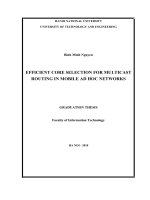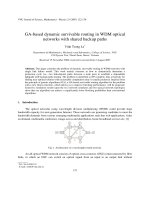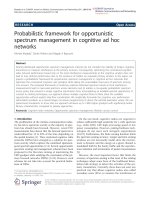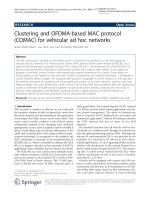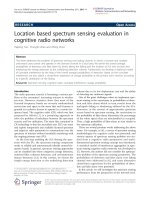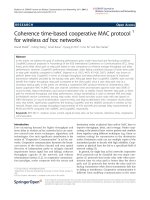Empty cell management for grid based resource discovery protocols in ad hoc networks
Bạn đang xem bản rút gọn của tài liệu. Xem và tải ngay bản đầy đủ của tài liệu tại đây (3.93 MB, 143 trang )
EMPTY CELL MANAGEMENT FOR GRID
BASED RESOURCE DISCOVERY
PROTOCOLS IN AD HOC NETWORKS
SEBASTIEN HEUGUET
NATIONAL UNIVERSITY OF SINGAPORE
2006
EMPTY CELL MANAGEMENT FOR GRID
BASED RESOURCE DISCOVERY
PROTOCOLS IN AD HOC NETWORKS
SEBASTIEN HEUGUET
(B. E., Supelec, France)
A THESIS SUBMITTED
FOR THE DEGREE OF MASTER OF ENGINEERING
DEPARTMENT OF ELECTRICAL & COMPUTER ENGINEERING
NATIONAL UNIVERSITY OF SINGAPORE
2006
Acknowledgments
I consider myself extremely fortunate to have been given the opportunity and
privilege of doing this research work by the National University of Singapore. I
would like to thank all the people who have helped me during my Master’s degree
program at the National University of Singapore.
I would like to express my deepest gratitude for Professor Kee Chaing Chua
and Professor Mehul Motani who accepted to be my supervisors and provided warm
and constant guidance throughout progress of this work. Their rich experience in
the field of communication networks has been extremely valuable for me and I have
learned a lot from them during our frequent discussions. This experience has been
a most valuable one.
My warmest thanks to the Computer Networks and Distributed Systems Laboratory officer Mr. Eric Poon and to the Open Source Software Laboratory officer
Mr. David Koh, I appreciate their helpful nature and dedication in making both
laboratories such nice places to work.
I am also thankful for the graduate research scholarship offered to me by the
National University of Singapore without which this Master’s degree programme
would not have been possible.
i
Finally, I would like to express my deep affection for my parents and my sister
who have supported and encouraged me throughout this work and for Fan Yi for
giving me stability, support and happiness.
ii
Contents
Acknowledgement
i
Table of Content
viii
Summary
ix
List of Figures
xvi
List of Tables
xvi
1 Introduction
1.1
1
The need for efficient resource discovery protocols in wireless ad hoc
networks . . . . . . . . . . . . . . . . . . . . . . . . . . . . . . . . .
1
1.2
The empty cell problem for grid based resource discovery protocols
6
1.3
Contributions . . . . . . . . . . . . . . . . . . . . . . . . . . . . . .
8
1.4
Thesis organization . . . . . . . . . . . . . . . . . . . . . . . . . . .
9
iii
2 Literature Review
12
2.1
Introduction . . . . . . . . . . . . . . . . . . . . . . . . . . . . . . .
12
2.2
Design Requirements . . . . . . . . . . . . . . . . . . . . . . . . . .
14
2.3
Connectivity based protocols . . . . . . . . . . . . . . . . . . . . . .
15
2.3.1
Selective Forwarding . . . . . . . . . . . . . . . . . . . . . .
16
2.3.1.1
Allia . . . . . . . . . . . . . . . . . . . . . . . . . .
17
2.3.1.2
Group-based Service Discovery . . . . . . . . . . .
17
Creating a node hierarchy . . . . . . . . . . . . . . . . . . .
18
2.3.2.1
Creating a dominating set . . . . . . . . . . . . . .
19
2.3.2.2
Backbone and selective forwarding . . . . . . . . .
21
2.3.2.3
Semantic Hierarchy . . . . . . . . . . . . . . . . . .
22
Quorums . . . . . . . . . . . . . . . . . . . . . . . . . . . . .
22
2.3.3.1
Creating fixed quorums . . . . . . . . . . . . . . .
23
2.3.3.2
Probabilistic Quorums . . . . . . . . . . . . . . . .
24
2.3.4
The small-world effect . . . . . . . . . . . . . . . . . . . . .
25
2.3.5
The global table approach . . . . . . . . . . . . . . . . . . .
27
2.3.2
2.3.3
iv
2.3.6
2.4
Conclusion . . . . . . . . . . . . . . . . . . . . . . . . . . . .
28
Location aided protocols . . . . . . . . . . . . . . . . . . . . . . . .
30
2.4.1
Geocasting and epidemic dissemination . . . . . . . . . . . .
31
2.4.2
The small-world effect . . . . . . . . . . . . . . . . . . . . .
33
2.4.3
Geographic quorums . . . . . . . . . . . . . . . . . . . . . .
35
2.4.3.1
Straight lines quorums . . . . . . . . . . . . . . . .
35
2.4.3.2
A spiral approach . . . . . . . . . . . . . . . . . . .
37
2.4.4
The Personal Home Region . . . . . . . . . . . . . . . . . .
37
2.4.5
The Grid Location Service (GLS) . . . . . . . . . . . . . . .
39
2.4.6
Grid based protocols . . . . . . . . . . . . . . . . . . . . . .
42
2.4.6.1
Flat Grid . . . . . . . . . . . . . . . . . . . . . . .
43
2.4.6.2
Hierarchical Grid with uniform repartition of the
servers . . . . . . . . . . . . . . . . . . . . . . . . .
2.4.6.3
Hierarchical Grid with logarithmic repartition of
the servers
. . . . . . . . . . . . . . . . . . . . . .
46
Location dissemination in hierarchical grid . . . . .
49
Conclusion . . . . . . . . . . . . . . . . . . . . . . . . . . . .
51
2.4.6.4
2.4.7
44
v
2.5
Conclusion . . . . . . . . . . . . . . . . . . . . . . . . . . . . . . . .
52
2.5.1
Strengths and weaknesses of grid based protocols . . . . . .
52
2.5.2
The effect of empty cells on grid based protocols . . . . . . .
53
3 Description of the Protocol
3.1
3.2
55
The design requirements of Hidagrid . . . . . . . . . . . . . . . . .
55
3.1.1
Basic strategies for empty cells management . . . . . . . . .
55
3.1.2
Requirements for empty cells management . . . . . . . . . .
57
Description of Hidagrid . . . . . . . . . . . . . . . . . . . . . . . . .
58
3.2.1
Assumptions . . . . . . . . . . . . . . . . . . . . . . . . . . .
58
3.2.2
Overview of Hidagrid . . . . . . . . . . . . . . . . . . . . . .
61
3.2.3
Advertising cell state changes . . . . . . . . . . . . . . . . .
61
3.2.3.1
The hierarchical grid structure . . . . . . . . . . .
62
3.2.3.2
The State Policy . . . . . . . . . . . . . . . . . . .
63
3.2.3.3
The spread of GRID UPDATE messages . . . . . .
63
3.2.4
Updating the node’s internal table . . . . . . . . . . . . . .
65
3.2.5
Routing messages hierarchically . . . . . . . . . . . . . . . .
66
vi
3.3
3.4
3.2.5.1
Changing the destination cell of a message . . . . .
67
3.2.5.2
The Relocation Policy . . . . . . . . . . . . . . . .
69
3.2.6
Relocating data items . . . . . . . . . . . . . . . . . . . . .
70
3.2.7
Detecting state changes
. . . . . . . . . . . . . . . . . . . .
71
3.2.7.1
Deactivation detection . . . . . . . . . . . . . . . .
71
3.2.7.2
Activation detection . . . . . . . . . . . . . . . . .
71
Improvements on the basic scheme . . . . . . . . . . . . . . . . . .
72
3.3.1
Hysteresis mechanisms . . . . . . . . . . . . . . . . . . . . .
72
3.3.1.1
Hysteresis at the cell level . . . . . . . . . . . . . .
72
3.3.1.2
Hysteresis at the region level . . . . . . . . . . . .
74
3.3.2
Generalizing the State Policy for any grid . . . . . . . . . .
74
3.3.3
Generalizing the Relocation Policy for any grid . . . . . . .
75
3.3.3.1
Justification of the Relocation Policy . . . . . . . .
76
3.3.3.2
Generalization . . . . . . . . . . . . . . . . . . . .
78
Conclusion . . . . . . . . . . . . . . . . . . . . . . . . . . . . . . . .
81
4 Simulation Results
83
vii
4.1
Implementation of a Simple Discovery Protocol (SDP) . . . . . . .
83
4.2
Simulation scenario . . . . . . . . . . . . . . . . . . . . . . . . . . .
85
4.3
Impact of Mobility and deactivation threshold . . . . . . . . . . . .
86
4.4
Static empty cells . . . . . . . . . . . . . . . . . . . . . . . . . . . .
94
4.4.1
Resource discovery performance of Hidagrid . . . . . . . . .
96
4.4.2
Comparison of SDP alone and with Hidagrid . . . . . . . . .
98
4.4.3
Overhead comparison . . . . . . . . . . . . . . . . . . . . . .
99
4.5
Sensitivity to mobility . . . . . . . . . . . . . . . . . . . . . . . . . 101
4.6
Varying the query rate . . . . . . . . . . . . . . . . . . . . . . . . . 106
5 Conclusion and Discussion
110
Bibliography
124
Publications
125
viii
Summary
From geographic routing to data storage in sensor networks, the discovery of the
resources shared is a vital feature of wireless ad hoc networks. The performances
of the grid based resource discovery protocols rank them among the most efficient
discovery protocols for ad hoc networks. In these location aware protocols, the
network topology is divided into geographical regions, called cells, and pieces of
information are stored and retrieved from a cell by using a given hashing function
and the unique identifier of the piece of information. However, because of obstacles
and nodes mobility, real mobility scenarios will create a heterogeneous density of
nodes on the field and thus there will be empty cells in the grid. This phenomenon
results in failures for most of the grid based protocols that have been proposed.
In this thesis, after an extensive review on the resource discovery protocols
in ad hoc networks, the issue of empty cells in the grid of a resource discovery
protocol is addressed. To solve this problem, we design Hidagrid, a fully distributed
protocol that manages the empty cells of a grid. Hidagrid relocates the data items
sent to empty cells and routes consistently the queries for such items. As a result,
Hidagrid acts as a sub layer located between the routing layer and a grid based
resource discovery protocol. It makes the actual grid appear homogeneous for the
grid-based resource discovery protocol. Extensive simulations, using a variety of
ix
mobility models and protocol parameters, show the severity of the empty cells on
the resource discovery performance. Using Hidagrid with the resource discovery
protocol then significantly increases the hit ratio and limits the communication
overhead of the resource discovery by avoiding sending messages to empty areas,
which creates useless traffic in the network.
x
List of Figures
1.1
The resource discovery problem: advertisements and queries are
spread over two sets of nodes such that both sets intersects. . . . .
4
1.2
Insertions and queries in a grid based discovery protocol . . . . . .
7
1.3
The adaptation role of Hidagrid: with Hidagrid, the actual heterogeneous grid appears homogeneous to the grid based discovery protocol. 10
2.1
Classification of the link based resource discovery protocols . . . . .
16
2.2
The grey nodes form a dominating set in the graph . . . . . . . . .
20
2.3
Resource discovery with quorums: Node A registers a resource in a
write quorum, Node B queries that resource in a read quorum. . . .
2.4
23
Resource discovery using two contacts: the source node sends the
query to its contacts which forward it to their own contacts . . . . .
26
2.5
Classification of the link based resource discovery protocols . . . . .
31
2.6
Location Query in DREAM and LAR: the query is geocasted in the
requested area. . . . . . . . . . . . . . . . . . . . . . . . . . . . . .
xi
32
2.7
Contact selection in ABSLM . . . . . . . . . . . . . . . . . . . . . .
34
2.8
Crossing lines in geographic quorums . . . . . . . . . . . . . . . . .
36
2.9
The spiral of node N is built on a hierarchy of rectangles. The nodes
close to the intersections of the spiral with the hierarchical rectangles
store the advertisements. A similar spiral is created for the queries.
38
2.10 Repartition of the servers for node A (ID = 21) in GLS: the node
with the least ID greater than 21 is elected server in each sibling
square of node A. . . . . . . . . . . . . . . . . . . . . . . . . . . . .
41
2.11 DLM with 3 levels, m = 1 and hierarchical discovery. Node S selects
one server in each region of level m, but only the server in S’s region
knows its exact location. The other servers point to the level m
region of S. . . . . . . . . . . . . . . . . . . . . . . . . . . . . . . .
45
2.12 Structure of HGRID for 3 levels. Node S sends a message to D in
three steps: 1) S issues a Location Query to find one of S’s leader;
2) The leader Li replies with a pointer to the leader Li−1 of D; 3) S
sends the message that is hierarchically routed from Li−1 to D . . .
3.1
48
Example of network supported by Hidagrid: the movement of the
nodes (numbers) is restricted by the obstacles (dark shapes), creating empty areas. . . . . . . . . . . . . . . . . . . . . . . . . . . . . .
xii
59
3.2
A 4 levels hierarchical grid with 6 level-3 regions, and the internal
table of the nodes located inside region 302. The hierarchy is depicted in the lower left corner and each hierarchical region is created
with four regions of lower level. The internal table lists the state of
the regions depicted on the figure. . . . . . . . . . . . . . . . . . . .
62
3.3
Pseudo code of the State Policy. . . . . . . . . . . . . . . . . . . . .
64
3.4
The internal table update mechanism: the dark node crossing the
cell border must update its internal table and sends an UPDATE RQT
message in the new cell. . . . . . . . . . . . . . . . . . . . . . . . .
3.5
66
Hierarchical routing of insertions and queries in the grid: Hidagrid
reevaluates the destination of the packet when it enters the region
of level level containing the destination cell of the packet. . . . . . .
67
3.6
Pseudo code of the hierarchical routing at each level. . . . . . . . .
68
3.7
Share of workload with the Relocation Policy when region 3 and then
region 0 close: the items stored in those regions are shared between
the active regions. . . . . . . . . . . . . . . . . . . . . . . . . . . . .
70
3.8
Unnecessary cell changes could be avoided with wide borders. . . .
73
3.9
Example of unstable grid if A(i) = 2 and D(i) = 2 for all levels. . .
75
3.10 Share of data items with two hashing functions: data items are
exchanged between two active regions, resulting in inefficiencies. . .
xiii
77
3.11 Sharing the indexes: Region R0 is deactivated and its index slice
[c, c + 5k − 1] is split into 5 sub slices that are attributed to each
active sibling region. . . . . . . . . . . . . . . . . . . . . . . . . . .
79
3.12 Generalized Relocation Policy: indexes are equally shared between
the active regions, spreading evenly the data items among the regions 80
4.1
Number of state changes vs deactivation threshold in a 4x4 grid. . .
88
4.2
Hit ratio vs deactivation threshold in a 4x4 grid. . . . . . . . . . . .
89
4.3
Negative replies vs deactivation threshold in a 4x4 grid. . . . . . . .
90
4.4
Queries which were not replied vs deactivation threshold in a 4x4 grid. 90
4.5
Number of messages sent by each node with Hidagrid for each mobility model (GM, RD, RW) and varying deactivation threshold. . .
4.6
Number of messages sent by each node with SDP alone for each
mobility model (GM, RD, RW) and varying deactivation threshold.
4.7
4.9
92
The maps used for the empty cells scenarios: each dark cell remains
empty during the whole simulation. . . . . . . . . . . . . . . . . . .
4.8
92
95
Performances of the resource discovery with and without Hidagrid
in an environment with static empty cells. . . . . . . . . . . . . . .
97
Percentage of queries which were not replied with static empty cells.
98
4.10 Percentage of negative replies with static empty cells. . . . . . . . . 100
xiv
4.11 Number of messages sent by each node with Hidagrid for RD and
RW in a static empty cells environment. . . . . . . . . . . . . . . . 100
4.12 Number of messages sent by each node with SDP alone for RD and
RW in a static empty cells environment. . . . . . . . . . . . . . . . 101
4.13 Maps used for the simulations with increasing query frequency. The
dark cells are empty during the simulations. . . . . . . . . . . . . . 102
4.14 Hit ratio of Hidagrid with different settings of Random Direction. . 103
4.15 Percentage of queries which were not replied with Hidagrid for different settings of Random Direction. . . . . . . . . . . . . . . . . . 103
4.16 Number of messages sent by each node with Hidagrid for different
settings of the Random Direction mobility model on Map 1. The
scale for the varying speed is different from the two other graphs. . 104
4.17 Number of messages sent by each node with Hidagrid for different
settings of the Random Direction mobility model on Map 2. The
scale for the varying speed is different from the two other graphs. . 105
4.18 Number of queries sent when the query frequency increases. . . . . 107
4.19 Hit ratio of SDP with and without Hidagrid vs inter query time. . . 108
4.20 Overhead of SDP with and without Hidagrid vs inter query time. . 108
4.21 Delay between the departure of a query and the arrival of the corresponding reply vs inter query time. . . . . . . . . . . . . . . . . . 109
xv
List of Tables
2.1
Comparison table of the link based protocols . . . . . . . . . . . . .
29
3.1
Messages used by the discovery protocol and Hidagrid . . . . . . . .
60
4.1
Simulation Parameters . . . . . . . . . . . . . . . . . . . . . . . . .
87
4.2
Protocols Parameters . . . . . . . . . . . . . . . . . . . . . . . . . .
87
xvi
Chapter 1
Introduction
1.1
The need for efficient resource discovery protocols in wireless ad hoc networks
Recent years have seen the explosion of wireless devices due to an increased need
for connectivity: cell phones and laptop equipped with wireless connections are
now all day life tools that were almost unknown 10 years ago. With this increased
connectivity came also a need for bandwidth in order to provide more and faster
services. For example, from the initial 2Mbps rate, the 802.11 protocol is now
developed in the 802.11g version that provides a rate of 54Mbps. These new technologies opened a whole new market and created in return connectivity needs from
the consumers who envision a fully connected world in the near future. Today’s
wireless technologies are mainly centralized architectures and they can be seen as
extensions of the existing wired networks, i.e., the wireless devices communicate
with a fixed station connected to the wired network. These stations act as gateways
between the mobile device and the network, and they are responsible for managing
1
Chapter 1. Introduction
2
communications in their vicinity. Such architecture requires large investments in
order to deploy these expensive infrastructures. Upgrading of such networks has
also proven slow and extremely expensive. Even if the initial investments have
been deployed, the need for alternate networks will be greater in order to provide
wide and flexible connectivity coverage in any place and at any time. Centralized
architectures cannot meet this objective because of the related costs. Mobile ad hoc
networks (MANETs) represent the complementary solution to cell oriented architectures as they can be easily deployed without any infrastructure. This seamless
approach could also be seen as the extension of the actual centralized architecture
in order to provide wider coverage in remote areas or during emergency or disaster
recovery scenarios.
In MANETs, all mobile nodes collaborate in order to transfer data between
two points of the network without the help of any dedicated device. The nodes
organize the network themselves and act as routers and servers for the whole network. Because of mobility and link weakness, the topology of the network continuously changes, raising many new challenges for researchers in an environment
where bandwidth and energy are scarce resources. Because of these constraints, ad
hoc networks perform poorly compared to centralized architectures. However their
ability to cope with any environment and the lack of investment could allow the
development of various new applications in the future for this kind of architecture.
As it is already the case today with Internet, a network is mainly used to
find information, transmit files and communicate with other users. Therefore the
first step for real deployment of MANETs is also to create an environment where
the nodes can cooperate, work and share resources and information without any
Chapter 1. Introduction
3
infrastructure. All the applications that will be developed for MANETs will rely
on the ability of locating a service, a file or a data item and exchange it. This
collaborative environment requires an efficient platform responsible for this task,
as it is already the case today for wired networks. Indeed, the internet would not be
as popular as it is now without good search engines. However, the approaches used
for fixed networks can not be derived for MANETs because of the new constraints
imposed in these networks. The topology continually changes, nodes are unreliable
and power limited, and they only have small storage and computation capacities.
The initial centralized solutions that were developed in the past can therefore not
be applied in MANETs. Decentralized (or peer-to-peer) protocols have also been
proposed later for wired networks [1, 2, 3], but they require an abundant bandwidth
that is not available in MANETs. Therefore new decentralized approaches must
be further studied to comply with the constraints brought with these networks.
Two obvious solutions to resource discovery in MANET could be proposed. First,
a node looking for a service or data item could simply flood the whole network
with a query (data pull), or on the opposite, a node sharing a service could flood
the network with an advertisement (data push). These two simple approaches
are not feasible in large ad hoc networks where flooding could be harmful for the
performances of the network [4]. Therefore a trade off has to be found where nodes
send some advertisements in specific places in the network that can be easily found
by a query for the corresponding item, resource discovery protocols manage this
mechanism.
Discovery protocols are not only useful at the application layer. Recently
many routing protocols for MANETs propose to use geographic information [5].
Contrary to the graph model protocols where nodes forward packets based solely on
Chapter 1. Introduction
4
Figure 1.1: The resource discovery problem: advertisements and queries are spread
over two sets of nodes such that both sets intersects.
their connectivity, geographic routing uses location information to forward packets
toward the destination. Therefore, they scale very well with the network size to
achieve good performance, but they require the implementation of a location service
to efficiently distribute information on nodes positions in the network. This problem is very similar to the resource discovery mentioned earlier, as shown in Fig 1.1,
i.e., given an identifier (here the destination node’s identity), where can a node find
the information related to that identifier (the destination node’s location)?
Sensor networks represent another class of self organizing wireless networks
where the constraints on throughput are relaxed. The applications implemented
on top these networks use little communication compared to MANETs. The main
goal of these networks is to improve the knowledge of an environment by gathering
Chapter 1. Introduction
5
information from many small sensors that are able to communicate with each other
and to perform simple computation tasks. The data collected is then computed
and transmitted for monitoring purpose. With sensor networks, many applications can be envisioned ranging from environment monitoring to health screening.
Many useful applications could benefit from sensor networks, i.e., industrial control, home automation, security and military sensing, asset tracking and supply
chain management are only a small sample of the commercial potential of these
networks. Throughput is however not the only difference between MANETs and
sensor networks. Indeed, energy consumption is the main constraint in these networks because it is proportional to the lifetime of the sensor network. Each node
stores a very limited amount of energy that cannot be recharged. The protocols
developed for these networks must therefore primarily focus on energy efficiency.
Due to the high number of sensors that could be spread on a field, scalability is also
a requirement for the sensor network protocols. These constraints associated with
node and link unreliability make sensor network a challenging environment for network researchers. Even if research efforts have been put in this area, many issues
have to be overcome in both hardware and software before effective deployment.
In sensor networks, the data processing mechanisms are very different depending on the application considered. In the case of monitoring, data items will be
locally analyzed and transmitted under certain conditions to a sink that will process
all the packets it receives, before taking a decision. Sensor networks could also be
used in unattended mode where the data collected is stored inside the network
before being extracted. This mode requires efficient mechanisms to retrieve the
relevant information in the network when a query is sent from a user. It has been
shown in [6] that data-centric storage is an efficient data dissemination scheme. In
Chapter 1. Introduction
6
this model, data item dissemination is solely based on the characteristics of sensed
data items. Therefore, similar data items are stored together, requiring an efficient
resource discovery protocol to retrieve information from the network.
The design of resource discovery protocols has been widely studied and many
solutions have been proposed in the literature, each with their niche of applicability.
However, the simulation results published so far show that the protocols using
geographic location to perform their task have very good performance in terms of
efficiency and scalability. This is true for routing protocols, as well as resource
discovery protocols. And we believe that this approach should be promising in the
future. Therefore, in this thesis, we focus on resource discovery protocols using
geographic location information.
1.2
The empty cell problem for grid based resource discovery protocols
Under the assumption that nodes are able to locate themselves, grid based resource
discovery protocols are used for a wide range of applications [7, 8, 9, 10, 11]. Service
or file discovery protocols, as well as location service could rely on this flexible
mechanism. In this kind of protocol, the network field is divided into geographical
regions that we call cells. These cells are responsible for storing and managing a
subset of the data items available in the network. The share of load among the cells
is determined with a hashing function, i.e., when inserting data item, a node hashes
the unique identifier of the data item to one of the cell in the network, called the
server cell for that data item. The server cell will then be responsible for storing
Chapter 1. Introduction
7
Figure 1.2: Insertions and queries in a grid based discovery protocol
the data item. A querying node carries out the same operation. Knowing the
identifier of the queried item, the identifier is hashed to a position in the network,
and a query is then sent to the cell. The mechanism is described in Fig. 1.2.
Das et al. [12] compare the performances of several categories of location
services and state that the category the grid based protocols belong to have the
overall best performances. However, the actual protocols assume that the node
density is roughly uniform on the network and that the grid is homogeneously
populated. In this case, all the cells in the grid are populated and no empty cell
appears in the grid. This assumption in large real scale networks in unrealistic for
two reasons. First, if the grid is not adapted to the geographic topology, obstacles
like buildings or natural obstruction (lake, hill, park) naturally create empty cells.
But even if the grid is customized, mobile nodes may also create empty cells when
moving. Consider, for example, a university campus where each student carries a
node. The node density varies according to the time schedule of the students, and
